|
I don't have a real barn yet on my farm. Still hope to have a nice old-fashioned barn with a hay-mow for loose hay someday, but in the meantime I've had to turn to very traditional methods of stacking my scythe cut hay and straw outdoors. I make two types of haystacks here at my farm: 1. A Romanian-style haystack, which consists of dried hay stacked upon a bed of tree branches, around a very tall, central pole, and stacked very high. 2. A tarp-covered, Pyramid-framed haystack of my own design. 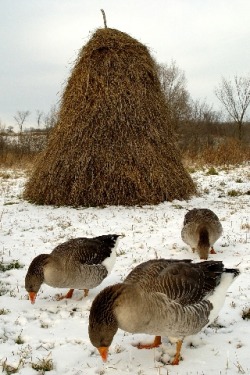 1. The Romanian-style haystack is made by stacking dried grass hay upon a bed of branches (4 pallets would work), around a very tall, central pole, which is braced with a tri-pod, and then the hay is stacked very high. The outside of the stack is then raked with a hayrake, to form a thatched outer shell. A very high and narrow, round shape, works best for this type of haystack. No need for a tarp covering. If formed and raked properly, the outer layer matts down into a very breathable, yet weather-proof shell. Hay stored this way, keeps a long time. The disadvantage though, comes when you want to use the hay. As soon as you break the outer shell and remove only some of the hay, the rest of the stack is then vunerable to the weather. Traditionally, all the hay in the whole stack would be hauled away to the barn, or some other form of covered shelter. Another disadvantage is that it has to be constructed in it's entirety at one time. Which means you have to have all your hay ready at one time (which takes a tremendous amount of hay), because the hay itself needs to be shaped and combed to become the "roof". With my Pyramid haystack, you can keep adding hay over time as it's ready, because it's "roof" is a removable tarp. If you want to learn about the Romanian style of haystack, there are excellent pictorials at http://www.hayinart.com/003028.html and http://leafpile.com/TravelLog/Romania/Farming/MakingaHaystack/MakingHaystack.htm . The people at Leaf Pile, are also publishing a photobook with essays on the rural life of Northern Transylvania, called "The Color of Hay: the Peasants of the Maramures" . It will be available in October 2010. You can order it at http://colorofhay.com/ A picture is worth a thousand words! 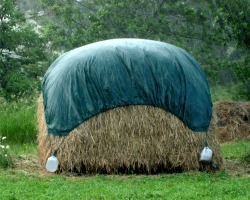 2. The Pyramid-framed Haystack. Necessity is the mother of invention. I invented this tarp-covered, pyramid haystack system, after many unsuccessful attempts to store my red clover/timothy/orchard grass hay (very heavy on the red clover) in other types of haystacks. The high red clover content made it difficult to get a good thatched seal on the outer layer of the haystack. The weather was able to penetrate too deeply into the stack, and the clover quickly rotted. Because I didn't have a barn to store loose hay, I needed a haystack that was close to my goose and duck houses, that I could remove hay from as needed, but would still protect the remaining hay, once some of it was removed. So I resorted to eliminating the central pole, raising the base, and covering my haystacks with a tarp. One day I had run out of sapling poles to make a haystack frame, and had to resort to using some salvaged scrap dimensional lumber. I had four warped 2x4's on hand, and since the yard tarps are square, I thought "Why not make a 4-sided pyramid instead of a tripod?" This resulted in a brilliant "Aha!' moment, and the whole structure for the pyramid haystack system suddenly came to mind. I was amazed at the geometric perfection of the proportions of the standard dimensions of the 8 foot 2x4's, 2x2's, and 1x2's, fit together with the 12'x12' yard tarp. It was as if a divine "Golden Ratio" of proportions had clicked into place. To top it off, I later discovered that a fully loaded Pyramid Haystack holds about 1 ton of hay. How neat is that! This system is very portable, and quick to set up. When the hay is all used up, it's easy to take down and store in your garage. Over the years however, I've started to leave my stack frames in the same place outdoors, even when empty. To increase the frames longevity, I switched to using 8' Cedar round fenceposts for the 4 uprights, and I set them on flat stones, or pavers, to keep the bottom of the posts from sinking into the ground and rotting. Because of the tarp "roof", this type of stack works best piled wide and square. I wish that there was a more ecological material, other than the plastic yard tarps, to use for the covering, but I haven't been able to come up with anything yet. If anyone would like to become involved with this project of finding a more suitable material for these haystack covers, and manufacturing them for scythe users, let me know! For updated info on how to make my Pyramid haystack frame go to http://onescytherevolution.com/1/post/2013/05/the-1sr-pyramid-haystack-update.html For a video of how I make make hay, see my YouTube video. Botan Anderson
26 Comments
Brigitte Fortin
5/24/2010 02:38:34 am
I need a hayrake please! Also, thanks for the detailed pics and instructions on making the haystack. Yours is the only place on the web that fits the scale of my farm and my desire to do it without fossil fuel. Please email or call me so I can get the hayrake and maybe give you a call to get some tips on making the stacking frame? 301-293-2716... or give me a number to call you at so I can pick up the charges? Thanks!
Reply
Barbara Irene Hicks
6/7/2019 08:18:16 pm
Hi Brigitte! My name is Barbara Hicks, and my husband Geoff and I moved into a 12-acre "farmette" last fall. We were poking around on the internet regarding scythes, as Geoff has just started using one here, and we saw your comment and your number, which appears to be from Maryland. Are you still in the area? We are in Clear Spring, west of Hagerstown. Take care! (By the way, did you ever get a hayrake?)
Reply
2/10/2025 01:21:04 am
Hello, thank you so much for this article and pictures...
Reply
Tiffani Cappello
8/12/2010 03:05:44 am
Great site and You Tube videos - a sincere thanks. We are going to start up our own farm here in OH soon and want to do our labor manually. What a blessing to be able to glean so much useful info from your site.
Reply
5/18/2011 03:42:43 am
I just made one this afternoon with french sizes and material. Your site is a true gold mine. Thanks a lot. from France.
Reply
Botan Anderson
5/18/2011 04:49:06 am
Thanks for your comments! I really appreciate them. I'm glad to hear that people are finding this info useful. Happy mowing!
Reply
Mark Parrish
6/27/2011 01:23:04 am
I'm sorry, I don't have a better suggestion for the roof. However, it does look like you could use shipping pallets 2x2 square and 2 tall (2x2x2) and achieve the same structure as your pyramid frame. If you can get hardwood pallets they should survive any kind of weather pretty well.
Reply
J pittmann
7/10/2011 12:41:41 am
thanks for the advice im going to mow my fields by hand now and its been so handy finding easy to follow advice like this.
Reply
10/28/2011 06:57:19 pm
We use used billboard tarps for winterizing our dairy goat barns (open front) to keep the snow out of the front portion. www.billboardtarps.com. You may need to cut them to size for your purpose and add grommets in the corners but they last a very long time, are a lot heavier duty than the standard tarps and are economical too.
Reply
As for the tarp on the top, you can buy old cotton sheets for very cheap in your local thift stores. You can soak them in raw linseed oil and then let hang outside in dry weather for several weeks to avoid the risk of spontaneous combustion. Then move them inside and let them finish drying for several months before using them on the haystacks. You can stitch several together or use multiple layers for greater protection. The drier you allow the linseed to get, the longer these will last, but linseed oil is definitely mildew food. This could be avoided if you were to add some copper or zinc napthenate to the linseed oil, but these are petroleum sourced. You could maybe treat the inside of the sheet with pure linseed, reserving these preservatives for the exposed side.
Reply
Arne Boveng
2/7/2013 07:16:25 am
I have an old photo from 1910 of a cabin in a natural meadow in present day Glacier National Park, from the homesteading era. It has an interesting network of tall poles, in a square grid pattern. Would you be interested in viewing the photo and giving an opinion as to the nature of the poles, in other words were they haying at this site? It is part of a homestead history project with in the park. Thanks.
Reply
Tim
4/22/2013 01:11:50 am
An ecological alternative to the yard tarp that still makes use of the water impermeability of man-made products is billboard vinyls. They're quite a bit bigger than your stacks but can be cut to fit whatever size or shape you want to make your stacks. There's a company I discovered near me that deals exclusively in reusable waste streams of industry and that includes billboard vinyls. I imagine plastic pallets would also provide better air circulation at the bottom of the stack (more like dead bushes) and last infinitely longer (literally!). (c: The company's website is www.repurposedmaterialsinc.com
Reply
Botan Anderson
4/22/2013 05:39:33 am
Thanks again for your comments. Re-purposing non-biodegradable materials is of course a great idea. I have tried the used billboards as suggested, and unfortunately found them to be too stiff and heavy for my pyramid haystack system. They did not form well to the shape of the stack and were enormously difficult to keep secured on the stack in high winds. Also, plastic pallets sound great for composters. They might be better as a haystack base than branches, for a Romanian style haystack, but don't forget the vertical component. Pallets on the ground by themselves, don't make good bases for haystacks. You need a framework for vertical support, and you would need to pile the hay quite high, for the stack to breathe. Simply piling a mound of hay on pallets and covering them with a tarp will result in moldy hay.
Reply
Micah
4/23/2013 10:09:58 am
If you were stacking the hay inside would you still want the airflow underneath or would it not be as much of an issue since it is not getting rained on? Would pallets be sufficient for indoor stacking?
Reply
Botan Anderson
4/23/2013 11:13:46 am
Hi Micah - If by inside, you mean on a dirt floor in a pole barn, I'd say yes pile the hay on pallets. You'll need some vertical support too, so maybe in a corner or stall. You don't want the hay to be wicking up any dampness from the floor.
Reply
Dermot Breen
6/30/2013 10:42:26 pm
Thanks for sharing your genius idea the Pyramid-framed Haystack. We built 2 of these for ricking hay during winter (2012-13). Last year was a bad year weatherwise in the UK & this Spring was grim too. We successfully store hay outdoors for this whole period using this method. We also tried wooden pallets on car tyres but this was nowhere near as effective. So we've started this years hay cut with scythes and I'm building 3 extra pyamid-framed hay ricks. In the meantime I also dream of acquiring a barn. Once again many thanks.
Reply
Leanne
10/27/2013 04:45:04 am
I have 100 acres and my hay equipment being held hostage ...long story. This is a life saver , however our weather has turned colder so I'm going to try and salvage what I can using the storage of my indoor riding arena and salt as a curing method
Reply
Michael Simonds
6/24/2014 06:53:58 am
I currently use the plastic drawstring type tarps too..but I'm looking at canvas drawsting tarps and possibly making them into oilcloth , a little pricey , but more natural and will last a lot longer.
Reply
Nick Segner
6/30/2014 04:56:43 am
Great info! I've got some barn space - once dried can my freshly cut hay be stacked in any sort of pile on pallets and maybe a tarp underneath?
Reply
kathleen
6/7/2015 11:49:09 am
Hi Botan, I finally got to use my scythe and hadn't seen your beautiful haystack idea. I saw a video of someone making a stack on an a frame with pole crisscrossed on top like a wigwam so hay could be stacked really high and the inside was empty - I had a sawhorse that I modified and stacked it up and the rest I piled in a bay on pallets in the barn. I am excited to try the pyramid style storage though = I think it will be much easier to stack and keep the hay better, One question - does this outside storage method work ok for horses? They are really sensitive to mold. Does the tarp and airflow keep things dry? I will be shopping for a hayrake soon - hope you've got one in stock. And a peening anvil if I continue to do this! Thanks for the great instructions and products!
Reply
Botan Anderson
12/13/2016 05:45:01 am
I have been testing out the used billboard tarps some more, as suggested above by Amanda above, and have figured out a better way to secure the tarp in high winds. I still find them awkward for the summer, but they are working well for me this winter.
Reply
Kayla Galgerud
8/16/2018 05:25:11 pm
Thank you so much for this!
Reply
Glan BlakeThomas
6/28/2019 02:25:44 am
how do you stop vermin and getting mold growth
Reply
5/7/2022 01:37:41 pm
Thank you for the informative website! I've been a professional, traditional Celtic storyteller & harper for over 30 years, as well as a writer. As a result of Covid & being elderly, I've spent most of the past couple of years isolating & writing, primarily fantasy novels (I have at least 4 or 5 that need to be edited). In my current WIP, I made a reference to something being higher than a haystack, then wondered how high that is. Thanks to you,I now know that I can say 8 ft. As a teenager at a Scout camp, I used both a sickle & a scythe; not easy work! This info will also be useful if I do a "farm program" storytelling at a school in the future; I always include some information sheets as well as have a Q&A period for the students at the end. Living as I do in Pittsburgh, I know that many kids have had no exposure at all to farm life & may vaguely think about tractors & silos beside barns. Thanks again! Respectfully, Barra Jacob-McDowell / Barra the Bard
Reply
Molly
7/28/2024 04:08:00 pm
Do you happen to know if the French in 1800's used similar construction as the Romaniian haystacks? See Claude Monet's painting series Wheatstacks". Was curious and thrilled to find a "how to" on building a haystack. (And yes discovered Monet painted more than water lilies). Loved the comments came from a variety of backgrounds. Primarily farmers and those seeking practical solutions but a researching author as well.
Reply
Your comment will be posted after it is approved.
Leave a Reply. |
Botan AndersonArchives
March 2023
Categories
All
|
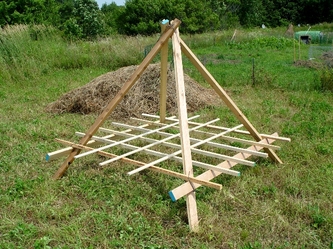
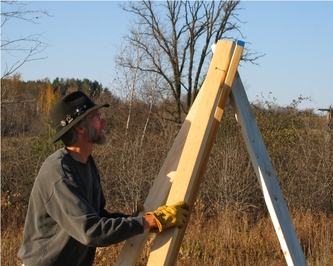
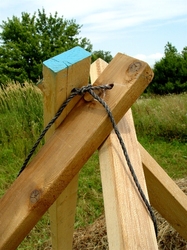
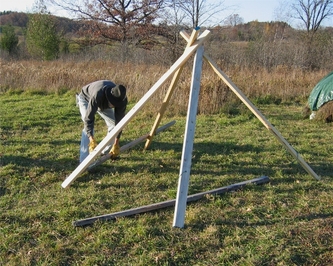

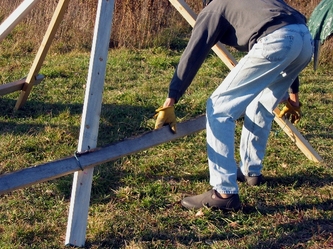
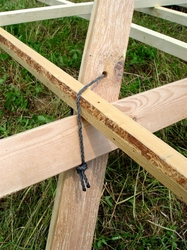
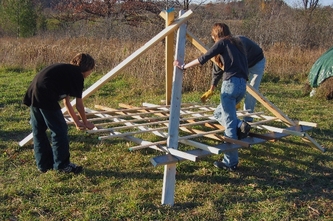
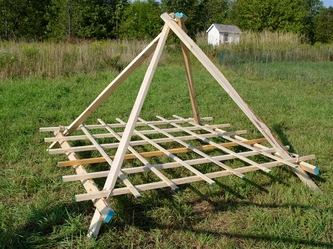
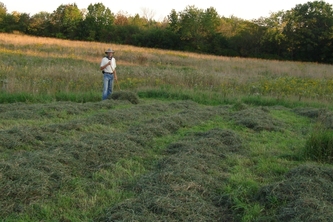
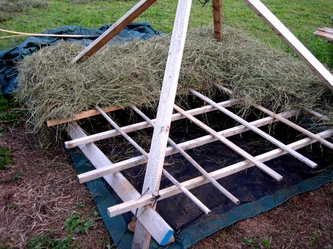
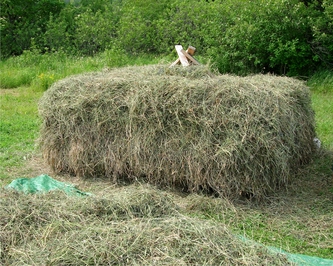
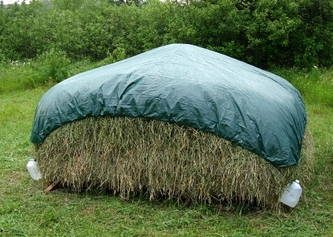
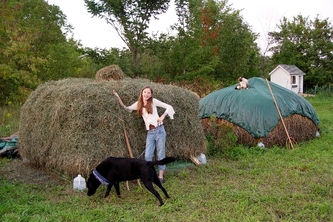
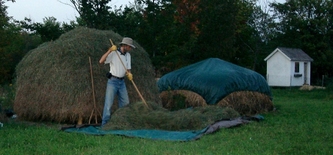
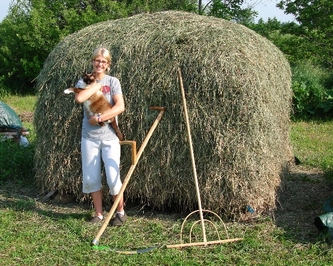
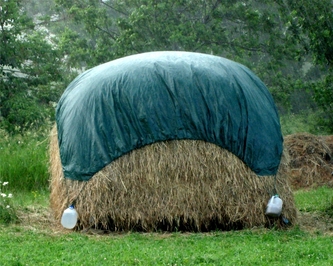


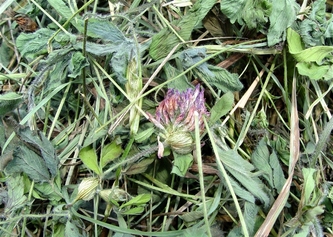
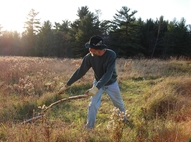
 RSS Feed
RSS Feed